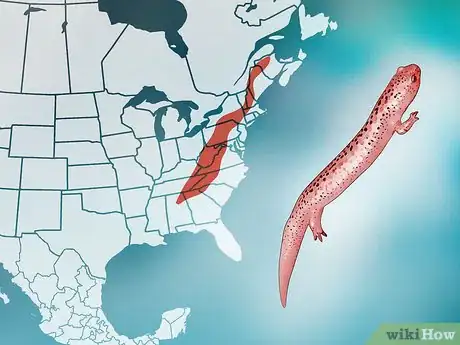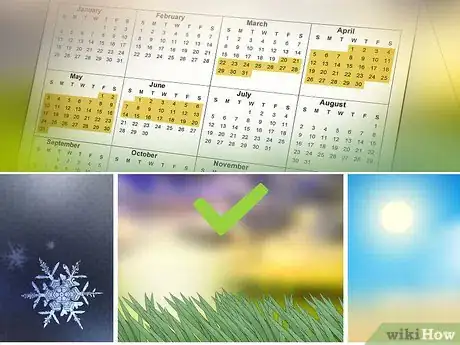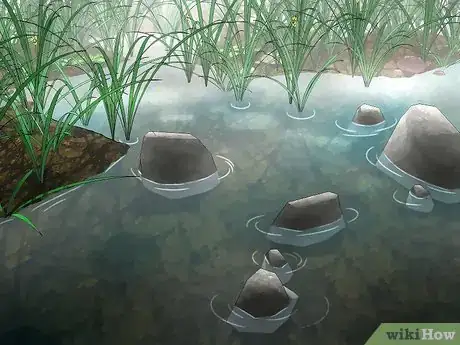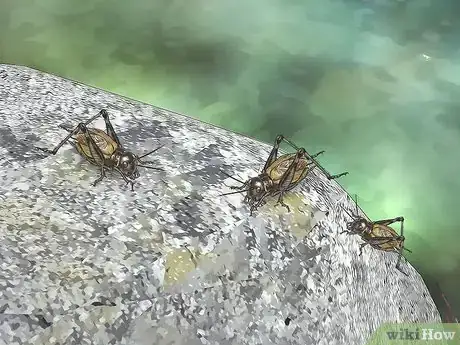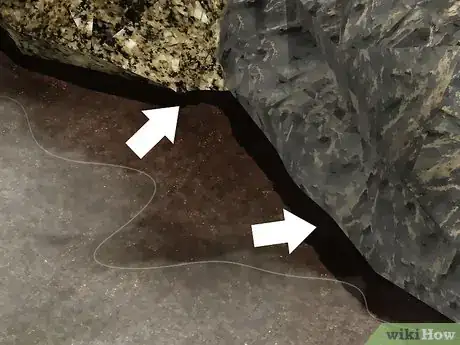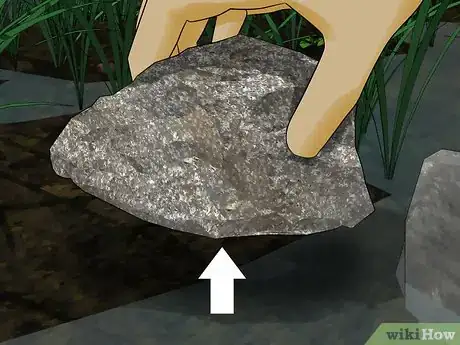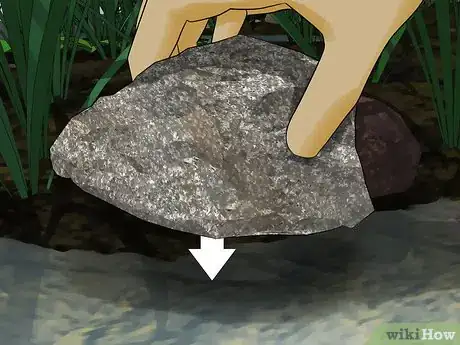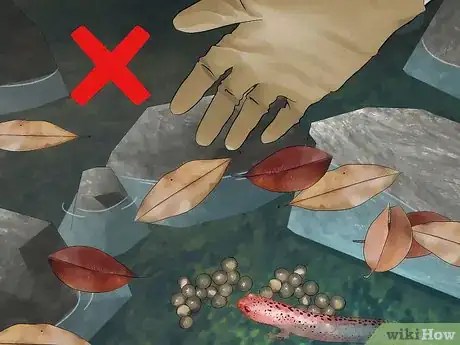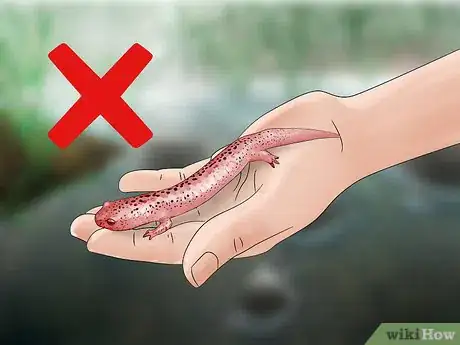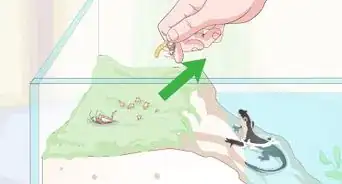This article was co-authored by wikiHow Staff. Our trained team of editors and researchers validate articles for accuracy and comprehensiveness. wikiHow's Content Management Team carefully monitors the work from our editorial staff to ensure that each article is backed by trusted research and meets our high quality standards.
There are 15 references cited in this article, which can be found at the bottom of the page.
wikiHow marks an article as reader-approved once it receives enough positive feedback. In this case, 89% of readers who voted found the article helpful, earning it our reader-approved status.
This article has been viewed 83,013 times.
Learn more...
Salamanders are a type of amphibian that strongly resemble lizards, but these creatures are quite different from lizards! These amphibians breathe through mucous glands that are located on their mouths, throats, and skin.[1] Since a salamander’s skin is required to be moist and slick to allow them to breathe, salamanders can be found living in humid and wet habitats. Searching for salamanders in the wild can be a fun, educational, and exciting adventure! To make the most of your experience, be sure to visit the salamander’s habitat during the right time of year and be sure to take care of the environment around you.
Steps
Visiting Salamander Territory
-
1Visit the salamander’s home. Travel to a geographical region where salamanders generally reside. One-third of all salamander species can be found in North America, specifically in the Appalachian Mountains region. Salamanders also reside throughout Central America, South America, Asia, and Europe.[2]
-
2Know what to look for. There are over 700 different species of salamanders in the world, and they all come in a variety of sizes and colors. Salamanders have long, smooth bodies and four limbs, and they can be a small as 2 inches long, while others can grow to 4 feet long![3] Some species of salamanders are brightly colored, which can indicate that they are poisonous.[4]
- The hellbender is a type of large salamander found in North America, which can grow up to 2.5 feet in length![5]
- Northern red salamanders are typically found in Maryland and live in natural springs. They are a bright, beautiful red with black flecks.[6]
- Some salamanders, such as the axolotl or the Mexican salamander, are pale pink or white. These types of salamanders live underground and are rarely exposed to sunlight.[7]
Advertisement -
3Wait for spring. Most salamanders live underground but will move out of dormancy in the spring to breed in vernal pools, which are shallow depressions in the ground that contain water during this time of year. This is the best time of year to search for these critters in the wild.
-
4Visit damp locations. Locations near wetlands, streams, rivers, ponds, marshes, and swamps are ideal locations for salamanders to make their home.[8] Most salamanders have a long larval stage and spend most of their early life in the water, much like frogs do.[9] These moist environments are ideal for catching a glimpse of these animals in the wild.
-
5Look in edge environments. Edge environments, or eco tones, describe areas where two different habitats meet.[10] Salamanders can often be found in these environments, so be sure to look near the shorelines of streams or near shrubs and bushes near shallow water.[11] Salamanders may also be found around seeps, which are areas where ground water slowly moves toward the surface.[12] Keep an eye out for springs, seeps, and other boggy areas where these amphibians often make their home.[13]
-
6Look for their food sources. Salamanders are carnivorous and eat a variety of insects and worms. In the wild, a salamander will eat crickets, worms, larvae, spiders, slugs—pretty much anything that it can easily swallow! If you know where to find their favorite meals, you may have a greater chance of spotting a salamander scurrying about.[14]
- Many of the insects in the salamander's diet can be found under logs, rocks, and branches, so you may spot a salamander lurking around these areas.
- Larger salamanders will often eat frogs and smaller salamanders, while aquatic salamanders will eat small fish, crayfish, and other small aquatic creatures.[15] If you come across a pool of still moving water with lots of rocks and tree roots, take a closer look! Crayfish are often found there, so your chances of spotting a salamander are greater.
-
7Search at night or on rainy days. Make plans to search for salamanders at night or when the weather is overcast and rainy. Salamanders are nocturnal and can usually be found at night; however, they may also venture out during daytime hours when it is cloudy or raining.
Searching for Salamanders
-
1Look under logs, rocks, and piles of leaves. Search for debris on the ground near wetlands and pools of water. Rocks, fallen logs, branches, and piles of leaves make ideal hiding places. Salamanders must keep their skin moist in order to breathe and hide under these types of objects to shelter themselves from direct sunlight.
-
2Slowly lift debris. Slowly flip over pieces of ground debris to find salamanders. Slow, gentle movements may prevent salamanders from becoming alarmed and scurrying away quickly to find another hiding place. Being careful while lifting the debris will help protect other living organisms that may have made their home there.
-
3Return the debris. Always return ground debris to its original position. Any major disruption to rocks, logs, and other debris could alter the humidity levels, the safety of a salamander’s habitat, and the safety of other living creatures in the area.[16]
Protecting the Salamanders and the Environment
-
1Don’t spend too much time in one area. Looking for salamanders in the wild can be a lot of fun, but be sure you don’t stay in one place too long. Disturbing leaves and logs and trampling through the grasses in a concentrated area can cause habitat degeneration and may upset the salamander breeding populations.[17]
-
2Stay away from breeding pools. If you stumble upon a salamander breeding pool, avoid disturbing it. Watch from a distance so that you do not harm the salamanders or their eggs.
-
3Don’t handle the salamanders. If it isn’t necessary to handle a salamander, opt not to. The oils on human skin can be toxic to salamanders, and the salt and heat from human hands can be harmful to them.[18]
Community Q&A
-
QuestionDo salamanders live in Wisconsin?
 Community AnswerYes! There are seven types of salamander in Wisconsin: the blue-spotted salamander, eastern newt, eastern red-backed salamander, eastern tiger salamander, four-toed salamander, mudpuppy, and spotted salamander. Hope this helps you in your salamander quest.
Community AnswerYes! There are seven types of salamander in Wisconsin: the blue-spotted salamander, eastern newt, eastern red-backed salamander, eastern tiger salamander, four-toed salamander, mudpuppy, and spotted salamander. Hope this helps you in your salamander quest. -
QuestionShould I keep my palms wet when handling a salamander?
 Community AnswerIf you have to handle a salamander, having wet or moist hands is ideal.
Community AnswerIf you have to handle a salamander, having wet or moist hands is ideal. -
QuestionWhere can I find a salamander?
 Community AnswerSalamanders may be found at the head of freshwater springs, under rocks and logs. They move very fast, and a small net about 6 inches in diameter helps catch them. All amphibians are in danger of extinction right now, and it would be wise to check state laws if you intend to capture and remove.
Community AnswerSalamanders may be found at the head of freshwater springs, under rocks and logs. They move very fast, and a small net about 6 inches in diameter helps catch them. All amphibians are in danger of extinction right now, and it would be wise to check state laws if you intend to capture and remove.
Warnings
- Never grab a salamander by its tail. A salamander’s tail will break off. It can regenerate, but it is best if this can be avoided.⧼thumbs_response⧽
- If you do handle a salamander, be sure to wash your hands immediately after coming into direct contact with a salamander. Some salamander species secrete poisonous chemicals that can cause skin irritation, and some reptiles have been linked to salmonella poisoning.[20] Washing your hands helps prevent the spread of these chemicals and bacteria.[21]⧼thumbs_response⧽
References
- ↑ https://www.tn.gov/twra/article/salamanders-of-tennessee
- ↑ http://www.scienceterrific.com/salamanders.php
- ↑ http://www.motherearthnews.com/nature-and-environment/salamander-species-zmaz07fmzpit
- ↑ https://www.softschools.com/facts/animals/salamander_facts/58/
- ↑ http://science.jrank.org/pages/5937/Salamanders-Salamanders-in-North-America.html
- ↑ http://www.mdsg.umd.edu/onthebay-blog/teaching-science-tv-search-salamanders
- ↑ http://www.worldanimalfoundation.net/f/Salamander.pdf
- ↑ http://infinitespider.com/spring-salamander-emergence-crossing-tunnels/
- ↑ http://www.scienceterrific.com/salamanders.php
- ↑ http://science.jrank.org/pages/2269/Ecotone.html
- ↑ https://books.google.com/books?id=mOewbhHSET4C&pg=PA36&lpg=PA36&dq=salamanders+near+seeps&source=bl&ots=9rSgZrxOWd&sig=jEZgwSztfy2mh6QJYIJM7g0AFQ0&hl=en&sa=X&ved=0ahUKEwjU2pydnsfQAhVByoMKHeTMBK4Q6AEIIzAB#v=onepage&q=salamanders%20near%20seeps&f=false
- ↑ http://www.massaudubon.org/learn/nature-wildlife/reptiles-amphibians/salamanders/salamander-species-in-massachusetts
- ↑ https://books.google.com/books?id=mOewbhHSET4C&pg=PA36&lpg=PA36&dq=salamanders+near+seeps&source=bl&ots=9rSgZrxOWd&sig=jEZgwSztfy2mh6QJYIJM7g0AFQ0&hl=en&sa=X&ved=0ahUKEwjU2pydnsfQAhVByoMKHeTMBK4Q6AEIIzAB#v=onepage&q=salamanders%20near%20seeps&f=false
- ↑ http://animals.mom.me/salamanders-diet-2710.html
- ↑ http://animals.mom.me/salamanders-diet-2710.html
- ↑ http://infinitespider.com/spring-salamander-emergence-crossing-tunnels/
- ↑ http://infinitespider.com/spring-salamander-emergence-crossing-tunnels/
- ↑ http://www.anapsid.org/sallies.html
- ↑ http://infinitespider.com/spring-salamander-emergence-crossing-tunnels/
- ↑ http://www.anapsid.org/sallies.html
- ↑ https://www.cdc.gov/features/salmonellafrogturtle/
About This Article
To find salamanders, wait until the spring since that's when salamanders come out from underground to breed. Search in damp locations, like streams, rivers, ponds, and swamps, which are where salamanders spend most of their time. When you're searching, look under logs, rocks, leaves, and branches, but move slowly so you don't scare the salamanders away. If you find a salamander, avoid handling it since the oils from your skin can be toxic to it. For tips on how to choose the best time of day and weather conditions to go salamander hunting, scroll down!
